With US$90 million in the bank and plenty of ground still to explore, Brisbane-based SolGold (TSX: SOLG; US-OTC: SLGGF) has embarked on a 120,000-metre, 12-drill program at its Cascabel copper-gold project in northern Ecuador.
The main purpose of the 2018 program is to expand the maiden resource at the Alpala deposit, one of 15 porphyry targets on the 50 sq. km land parcel.
According to an estimate released in January, Alpala has an indicated resource of 430 million tonnes grading 0.5% copper and 0.4 gram gold per tonne (or 0.8% copper equivalent), plus 650 million inferred tonnes at 0.4% copper and 0.3 gram gold (or 0.6% copper equivalent), using a lower cut-off grade of 0.3% copper equivalent. This equates to 7.4 million tonnes contained copper and 12.3 million contained oz. gold in all categories.

Bayardo Rosero (left), senior geologist, and Jason Ward, country manager, at SolGold’s Cascabel copper-gold project in Ecuador. Credit: SolGold.
The deposit’s higher-grade core contains 120 million tonnes grading 1.8% copper equivalent.
“The drilling we are doing right now is focused on the high-grade resource, and the high-grade resource is getting bigger,” says SolGold CEO Nicholas Mather, a geologist with 32 years of exploration and management experience, in a phone interview.
One of the 12 drills is headed for the Aguinaga prospect — 3 km northeast of Alpala — where the first hole has intersected porphyry-style veining, chalcopyrite and bornite mineralization from 295 metres’ depth. Previous surface sampling returned 1.01% copper and 0.7 gram gold per tonne in channel samples.
Cascabel lies along the margin of the Eocene and Miocene metallogenic belts that stretch along the Andes from Chile to Panama and host some of the world’s biggest copper porphyry deposits, including Escondida in Chile and Cobre Panama (3.2 billion tonnes grading 0.38% copper) to the north. Ecuador is relatively unexplored for minerals compared to its copper-producing neighbours.
Cascabel is a grassroots success story in the sense that SolGold has found a mineralized envelope with a true width of up to 800 metres, more than 1,500 metres long and extending 1,800 metres from surface, since the junior acquired the early-stage project from Cornerstone Capital Resources (TSXV: CGP; US-OTC: CTNXF) in 2012 and received an exploration permit the following year. Cornerstone still has a 15% interest, but SolGold is funding 100% of the exploration.

Nicholas Mather, CEO of SolGold.
“Some rock-chip samples in the area contained copper, silver, lead and zinc, but nobody had recognized a porphyry system,” Mather says of SolGold’s early reconnaissance work. “What attracted us to the project was molybdenum, which — plus or minus gold — is indicative of these large porphyry systems.”
SolGold continued prospecting and found highly altered lithocaps at Alpala. Sheeted veining at the bottom of the creek running through the middle of the project suggested that a porphyry system might underlie the altered rocks.
Sure enough, drilling under the creek outcrop hit copper sulphide mineralization in the first hole.
By the end of March 2018, SolGold had drilled 92,500 metres into the system.
Yet the market has been unresponsive to the growing potential at Cascabel, despite SolGold’s ability to attract high-profile shareholders such as Newcrest Mining (ASX: NCM; US-OTC: NCMGY), at 14.5%; Guyana Goldfields (TSX: GUY; US-OTC: GUYFF), at 6.1%; and global investment firm BlackRock, at 5%. (Mather owns 90.7 million shares, or a 5.4% interest.)
At press time SolGold was trading at 40¢ in a 52-week range of 34–95¢, and had a $670-million market capitalization.
Mather says investors might assume the maiden resource is all the project has to offer, a thesis Toronto-based Cormark Securities — one of the underwriters of a bought-deal financing at 42¢ that raised $75.6 million in late 2017 — supports.
“SolGold currently experiencing a lull following a wave of profit taking and the 2018 drill program, which will triple the meterage used in the maiden resource, is a clear catalyst for the next wave of interest,” Cormark analysts Tyron Breytenbach and Nicolas Dion said in a March research report.
Investors may also be wary of sinking money into a country where political risk is high. Ecuador ranks 117th the out 175 countries in Transparency International’s Corruption Perceptions Index and 118th out of 189 countries in the World Bank’s Doing Business Index for 2017.
Ecuador hopes to become more attractive as a destination for mining capital by changing the tax code that drove Kinross Gold to sell its interest in 2014 in the large Fruta del Norte gold project in southern Ecuador in 2014. Lundin Mining bought the project and has negotiated with the government to lower the tax burden to a much more competitive level.

Location map of SolGold’s Cascabel copper-gold project in Ecuador. Credit: SolGold.
Fruta del Norte could begin production by the end of 2019, producing 325,000 oz. gold annually for 15 years. The project got a major push earlier this year when Newcrest — SolGold’s major shareholder — invested US$250 million as part of a US$400-million financing for construction.
Proposed changes to the country’s regulatory framework and tax regime are paying off. Ecuador expects to reap over US$1 billion in revenues 2018, mainly through mineral exploration and mine development. In a release several months ago, Ecuador’s mining ministry said the income would come from 300 recently approved mining titles, as well as royalties from production.
Cascabel is in a relatively favourable location in terms of infrastructure, elevation and water supply. The project has access to low-cost hydro; is three hours north by road from the capital Quito and 180 km from deepwater ports; and sits at a moderate elevation — by Andean standards — of 600 to 1,800 metres.
Rather than risk its social licence by digging an open pit, SolGold plans to mine Alpala with block caving if it reaches production. The method uses gravity and undercutting techniques to accelerate natural fragmentation and allow the ore to collapse under its own weight. Newcrest uses the method at the Cadia Valley gold mine in Australia and plans to use it at the Wafi-Golpu copper-gold porphyry project in Papua New Guinea.
“Block caving is spectacularly efficient and has no environmental or social impact,” Mather says. He points out that Codelco is using block caving to go underground at the giant Chuquicamata copper porphyry deposit in Chile — the world’s second deepest open-pit mine. The underground mine will cost an estimated US$4.2 billion to build and is expected to produce 366,000 tonnes copper and 18,000 tonnes molybdenum per year starting in 2019.

Workers in the core shack at SolGold’s Cascabel gold property in Ecuador. Credit: SolGold.
In the meantime, SolGold will continue drilling to expand the Alpala deposit and test satellite targets on the property. Moran and Tandayama-America are ready for drilling, and drill-targeting studies are underway for Chinambicito, Alpala South, Parambas and Cristal. The company also controls four subsidiaries that together own more than 3,000 sq. km of unexplored porphyry terrain within the Ecuador expression of the copper belt.
“People shouldn’t be worried about the future,” Mather says.
— Virginia Heffernan is a freelance writer specializing in mining issues, and a principal of Toronto-based GeoPen Communications (www.geopen.com).

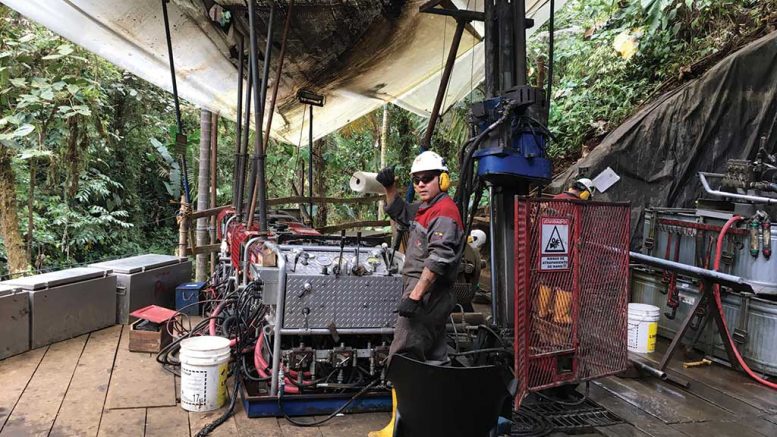
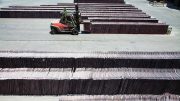
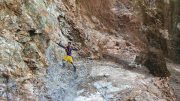
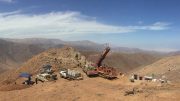
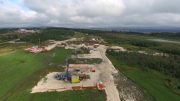
Be the first to comment on "SolGold steps up drilling campaign in Ecuador"